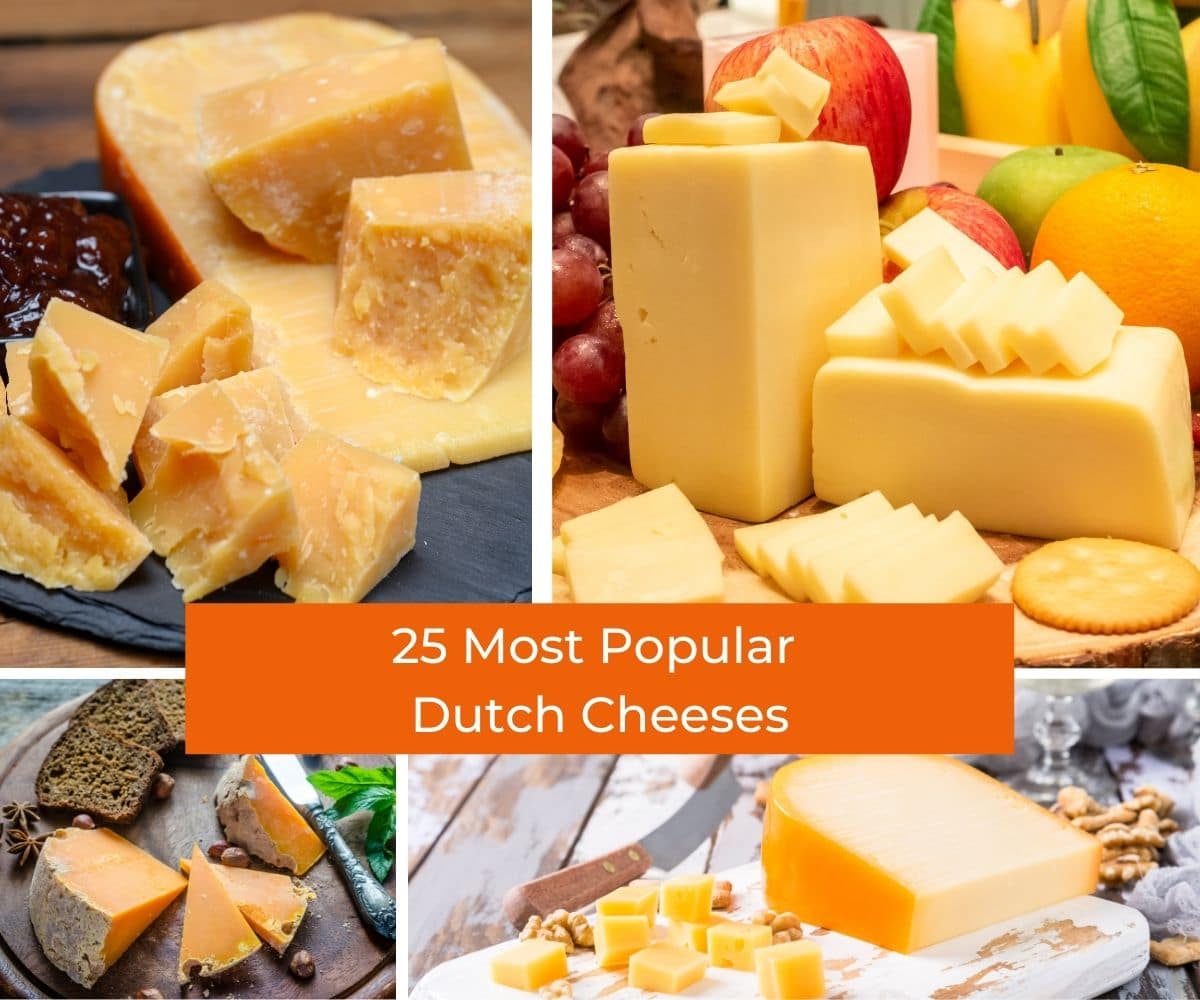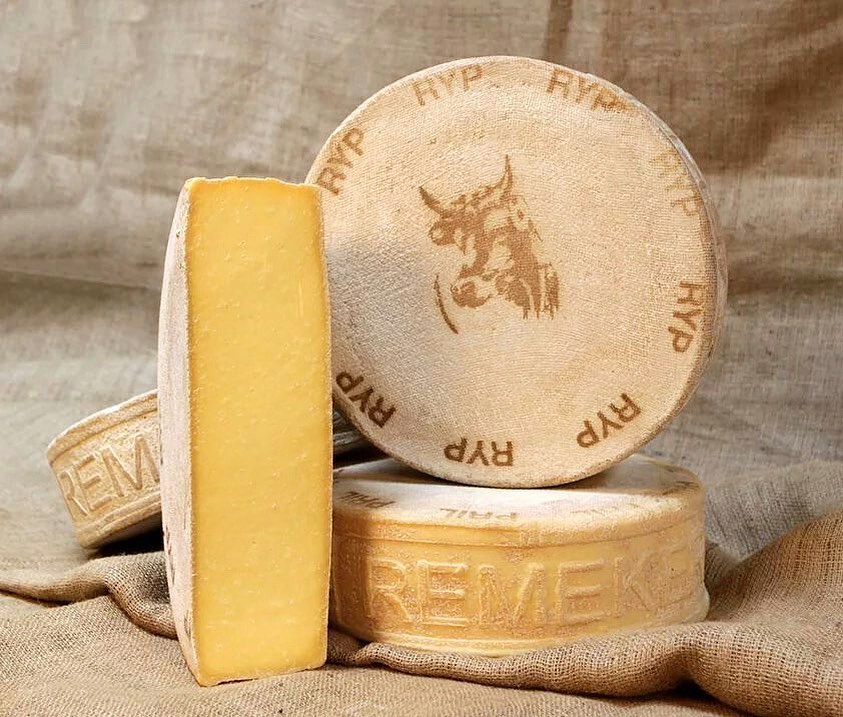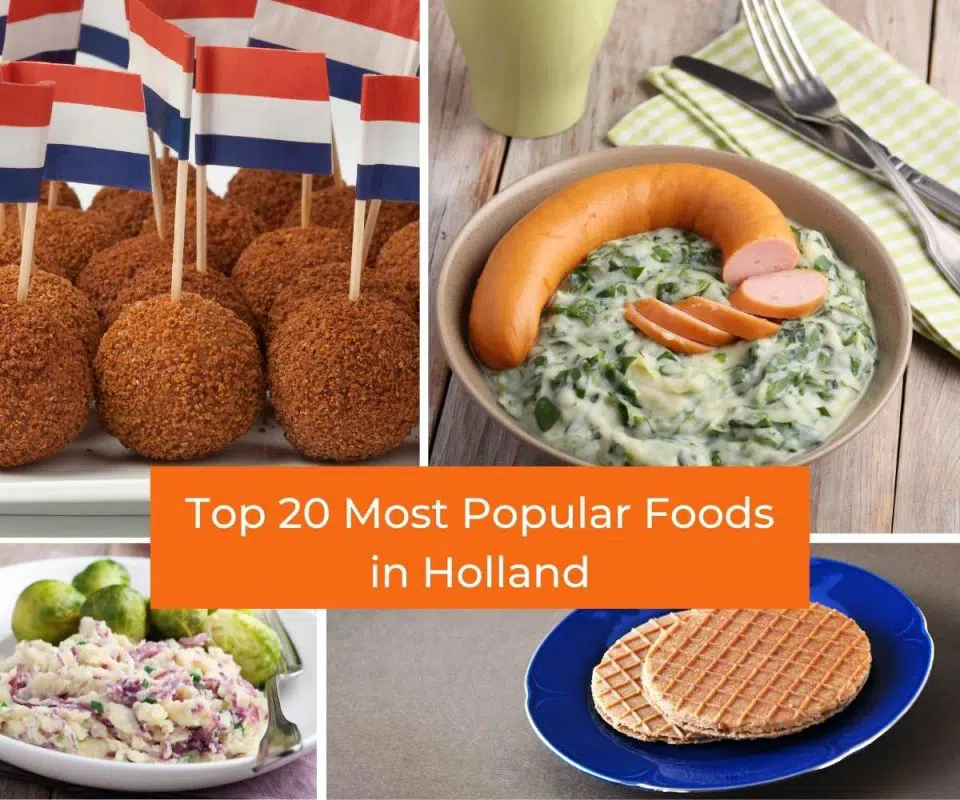25 of the Most Popular Dutch Cheeses

The Netherlands is renowned for many things, and its variety of famous cheeses is certainly one of them. In addition to famous regulars like for example Edam or Gouda, there are a lot more varieties that are eaten regularly by the Dutch.
In this article, we will take a look at 25 of the most popular Dutch cheeses, in the following categories:
- Cow cheeses
- Red, white and blue cheeses
- Goat and sheep cheeses
Dutch Cow’s Milk Cheese
Most Dutch cheeses fall into this category. There are hundreds of them. Just about every town or village has at least one farm that produces one or more kinds of hard or semi-hard cow cheese.
1. Edam

Edam is known all over the world, with its distinctive spherical shape and covered in red wax coating for export. In the past, the red crust was made with the juice of poppies!
It gets its name from the town of Edam, where the cheese was originally traded. It’s a 40+ cheese, which means it contains 25% fat.
2. Gouda

Gouda cheese -in Dutch goudse kaas– is a very famous hard cheese from the Netherlands. It is shaped like a wheel, and is one of the biggest export products of the country. A whole wheel weighs between one and sixteen kilos.
Gouda cheese is also produced in other countries as the name and brand are not protected. However, since 2010, the name Gouda Holland has been geographically protected by the European government.
Gouda cheese comes in many varieties, from mild to strong, depending on the age of the cheese. The longer the cheese is ripened, the stronger the taste.
3. Leerdammer

Leerdammer cheese is a pasteurized, semi-hard cow cheese with holes in it. It’s a popular cheese in the Netherlands. One slogan well known among the Dutch is: De lekkerste kaas tussen de gaten, which transaltes as: “The best cheese between the holes.”
The taste is somewhat similar to Emmental cheese but it’s a bit softer. When it’s aged, it gets a really nice nutty flavor. These older Leerdammer cheeses go very nicely with tawny port wine.
4. Remeker

Remeker is a famous Dutch cheese produced on one cheese farm in the Dutch province Gelderland. This cheese has won several awards because of its high quality.
Remeker is made from unpasteurized milk that comes from farm-reared Jersey cows. The cows primarily eat grass and clover, and only eat a little bit of non-processed rye and oat.
This cheese is highly recommended by professionals in the culinary world, and you can find it on the menu at many of the best Dutch restaurants.
5. Stolwijker

Stolwijker is produced in the Dutch village Stolwijk, not far from Gouda. A true farmers’ cheese, it is made from unpasteurized milk, and has a lovely, full, aromatic flavor. It’s only produced by farmers and not in factories, and you can taste the difference.
It’s a great snack, and it’s also a lovely dessert. Stolwijker and a full-bodied red wine make a great combo.
6. Friese Nagelkaas

Friese nagelkaas is a cheese from Friesland, a province in the north of the Netherlands.
This cheese has a long history. It was developed for sailors of the Dutch East India Company. Skimmed milk was used, and cloves and cumin were added to spice up the bland flavor. Due to the preservative qualities of cloves, this cheese was ideal for long journeys.
7. Hooidammer Cheese

Just like friese nagelkaas, Hooidammer is from Friesland. It’s made in the town of Heerenveen by cheesemaker Henri Willig. Actually, Hooidammer is a collective name for several varieties of organic cheeses. All Hooidammer cheeses have a vegetarian quality mark.
8. Beemster Cheese

Beemster is named after the region it originated from: De Beemster in Zuid-Holland. This region used to be below sea level, which provides it with very specific soil. The grass in this region is a bit salty, which you can actually taste in the cheese.
This cheese is Dutch but is aged in Belgium; after it has dried for two weeks, it is transported to a specially designed aging facility across the border, with perfect temperature and humidity. Some cheeses ripen there for up to three years.
This cheese pairs nicely with a Belgian beer or a light red wine.
9. Old Amsterdam

Old Amsterdam is an older cheese that, despite the name, is not produced in Amsterdam. It’s produced in Huizen, which is also in the province Noord-Holland, just like Amsterdam. This cheese is ripened for about eight months. It has a nice, salty flavor and a crumbly texture.
It’s the perfect choice to serve at social gatherings, and it goes nicely with fresh a white wine like Sauvignon Blanc or Grüner Veltliner.
10. Maaslander

Maaslander is made by the same company as Old Amsterdam, but its aging process is shorter, therefore it’s milder and moister than Old Amsterdam cheeses. Due to a big marketing campaign when the cheese was introduced, just about everybody in the Netherlands knows this cheese.
11. Graskaas

Graskaas (grass cheese) is a special cheese made by farmers all over the country. Produced in the springtime, it uses the milk that is produced just after the cows are let out of the stables, the moment when can eat the fresh grass again.
This grass-only diet lends the cheese a very natural and unique flavor. Grass cheese contains more carotene due to the consumption of grass which gives it an extra yellow color.
12. Commissiekaas

Commissiekaas, also called Mimolette or Dutch Mimolette is a cow cheese. Twice as big as an Edam cheese, it also has the same shape as that of an Edam, and the color of the crust ranges from orange to red.
Surprisingly, this cheese is somewhat rare in the Netherlands, but it’s very popular in Belgium and France.
Originally it was a French imitation of Edam cheese. In the 17th century, foreign cheeses were banned in France, and they were given that distinctive orange/red color to differentiate themselves from the Edam.
13. Leidse Kaas

Another famous cheese from the Netherlands is Leidse kaas. It’s produced in the city of Leiden, in the province Zuid-Holland. The addition of cumin gives it a nice and characteristic flavor.
Leidse kaas contains less fat than most other Dutch cheeses, giving it a somewhat solid structure. It goes down nicely with a strong beer or a glass of red wine, preferably a Merlot.
14. Fryslaner Kaas

Fryslaner kaas is another cheese produced in Friesland. The milk is produced on several organic farms in Friesland. This cheese has a salty flavor, and is quite strong. It also has a remarkable smell. Dutch people regard it a great cheese to eat as a snack. It combines well with a glass of aromatic white wine, like a Viognier.
15. Hervekaas

Hervekaas is a soft, smelly cheese made in Limburg, the most southern province of the Netherlands. Locally they call it rommedou or Limburgse stinkkaas (stinky cheese).
This cheese is famous all over the world, referred to in the United States as Limburger. It has a strong flavor and most people eat it for dessert. It tastes delicious with a dark beer or a tawny port wine.
16. Ruygentaler

Ruygentaler is made in Oudewater, in the Dutch province of Utrecht. It’s made from unpasteurized milk, and has many holes in it. It features a grey coating and looks a bit like Swiss cheese. A whole Ruygentaler cheese weighs roughly 13 kilos, and it is aged for two months.
This cheese is especially popular in Germany.
Dutch Sheep- and Goat Milk Cheese
17. Texelse Schapenkaas

Texelse schapenkaas (goat cheese) comes from Texel, a Dutch island known for its many sheep and sheep cheese. This goat (not sheep) cheese is made from unpasteurized milk and boasts a pale color. Given Texel’s location in the North Sea, Texelse schapenkaas has a nice and salty flavor, without ever becoming too sharp.
It goes well with a fresh white wine, like for example Sauvignon Blanc, Chenin Blanc or Grüner Veltliner.
18. Terschellinger Schapenkaas

This cheese is also made on one of the Dutch islands, Terschelling. Perhaps the best Dutch sheep cheeses are all made on islands! The salty winds are ideal for making good sheep cheese.
Produced on the De Zeekraal farm,” it won the award for best sheep cheese in the Netherlands in 2018.
19. Doetie’s Cheese

Doetie Trinks was the deserved winner of Best New Product in Agriculture in 2020. She has a relatively small farm with 75 sheep, from the rare breed Toggenburger. The sheep only eat high-quality non-processed food and her sustainable way of working makes sure her farm produces little Co2.
Doetie’s goat cheeses are mild cheeses full of flavor. They pair nicely with a white wine like Chardonnay, or a red wine like a Beaujolais.
20. Amaltura

Amalture goat cheese is made in Brabant, a Dutch province in the southern part of the Netherlands. It goes great on a pasta dish, but also as a snack with a nice glass of red wine, for example, a Grenache or Syrah.
In 2016 this cheese won the prestigious Superior Taste Award, awarded by a panel of top chefs and sommeliers.
Dutch Red, White and Blue Cheeses
21. Bleu de Wolvega

The Bleu de Wolvega is a famous cheese from Wolvega, a village in the southern part of Friesland. It’s a creamy cheese with a mildly spicy flavor. It’s made from pasteurized cow’s milk and is aged for six months.
It is often used in salads and also functions perfectly as a dessert. This cheese is a wonderful combination with older port wine.
22. Lady’s Bleu

Lady’s Bleu is a blue cheese made from goat milk from in the Dutch province of Drenthe. It’s a cheese with a silky structure and a spicy flavor. Put your feet up, eat some Lady’s Bleu and enjoy life.
23. Reade Jutter

Reade (red) Jutter is a red cheese from Terschelling, one of the above-mentioned Dutch islands. It is made with vegetarian rennet and the milk comes from three local organic farmers.
The Reade Jutter has a lovely mild and soft flavor. It carries the Organic Quality mark, which is becoming more and more important nowadays.
24. Kernhem cheese

Kernhem is a red cheese which is, somewhat surprisingly, made by the NIZO (Nederlands Instituut voor Zuivelonderzoek, now called NIZO Food Research), a dairy research facility in the Dutch town of Ede, in the Gelderland province.
It’s a modern cheese with a nice and mild flavor. The cheese remains a bit soft on the inside.
25. Petemoei

Petemoei cheese is a Dutch white cheese, also made in Gelderland. It is sometimes referred to as the Dutch Camembert. When young, it has a very fresh taste with a nice acidic touch. As it gets older, the flavors become earthier and stronger.
It combines very nicely with a red Bordeaux wine, or with a glass of Champagne.
Conclusion
As you can see, the Netherlands is a paradise for cheese lovers. There are cheese farms near just about every city, town, or village, and cheese of all varieties can be found in every supermarket.
Cheese is traditionally eaten on sandwiches for breakfast and lunch, but also for dessert or as a snack at parties. No Dutch birthday party is complete without some kind of cheesy snack.
Most towns boast at least one cheese shop. Should there be several, it’s worth visiting them all, as they will usually carry different regional cheeses.
A lot of cheese farms have also their own shop, and most farmers will happily give you a tour of the farm if you ask for one. It’s a good way to get to know the Dutch people and their habits… and you get to enjoy some nice cheeses as well!
Before you go, check out our articles on the 20 most popular Dutch foods and the most popular Christmas food in the Netherlands.



